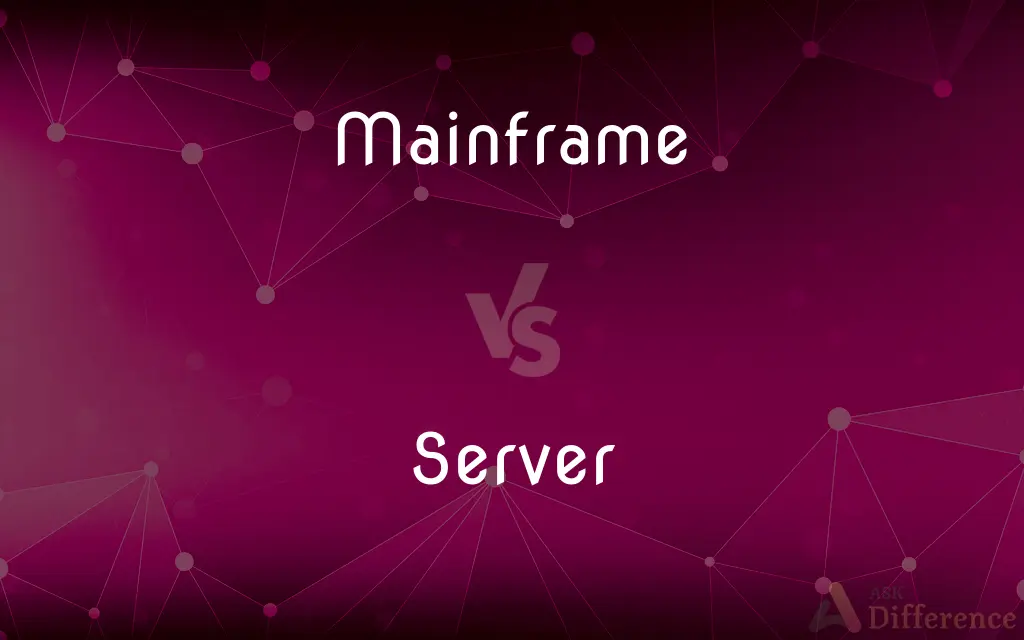Mainframe vs. Server — What's the Difference?
By Tayyaba Rehman — Updated on October 31, 2023
Mainframe is a large, powerful computer for extensive processing; a server is a system that provides resources or services.

Difference Between Mainframe and Server
Table of Contents
ADVERTISEMENT
Key Differences
Mainframes are computers designed for large-scale processing, supporting numerous users and applications simultaneously. They excel in reliability, scalability, and security, typically used by banks, airlines, and government agencies for critical applications and massive data processing tasks. Servers, on the other hand, are computers that provide data, resources, services, or programs to other computers, known as clients, over a network. While a server can be as simple as a personal computer serving files, it can also be part of a larger data center, supporting a moderate number of users and tasks compared to mainframes.
Mainframes have a history dating back to the 1950s, evolving from the room-sized systems to modern high-capacity machines. Their architecture is designed to prioritize uptime, processing power, and centralization of resources. Servers, introduced later, vary in size and purpose, from small office servers managing file sharing to dedicated servers in data centers handling web traffic, databases, or email services. They are typically less expensive and easier to integrate into a decentralized network structure than mainframes.
In terms of operation, mainframes handle a high volume of transactions and are often the backbone of enterprise computing. They process critical operations reliably, ensuring data integrity and security for sensitive transactions. Servers, while versatile, focus on serving the needs of network clients, which can range from serving web pages on the internet to hosting multiplayer gaming environments. They are built to manage network resources and provide services like computing power or storage rather than handling high-volume transaction processing.
While mainframes are engineered for large organizations that require extensive batch and transaction processing capabilities, servers are tailored for more diversified tasks, including serving websites, running applications, or storing data. Mainframes use specialized operating systems and software designed for task efficiency and stability. Servers are often equipped with common operating systems like Windows, Linux, or Unix and can run a wide range of software tailored to the services they provide.
The cost of operation and maintenance sets mainframes and servers apart significantly. Mainframes require specialized environments, high maintenance, and often a workforce with specific expertise, making them a significant investment. Servers, on the other hand, are less costly to maintain, more flexible, and can be scaled by adding more servers into a network as needed, aligning with the demands of businesses of varying sizes.
ADVERTISEMENT
Comparison Chart
Primary Use
Large-scale transaction processing and centralized computing for multiple users.
Providing services like web hosting, file sharing, and application hosting to client machines.
Scale of Operation
Designed for enterprise-level operations with high availability and reliability.
Can range from small-scale operations to large data centers, but typically below mainframe capability.
Cost
Typically higher initial investment and maintenance costs.
More varied, generally lower costs and maintenance expenses.
Flexibility
Mainframes are less flexible, often requiring specialized software and hardware.
Servers offer greater flexibility, can be customized with different OS and software.
Typical Users
Large organizations in sectors like finance, government, and healthcare.
Small to large businesses, personal use, and varied industry applications.
Compare with Definitions
Mainframe
A high-capacity computer for bulk data processing and enterprise management.
The mainframe processed all the bank's transactions overnight.
Server
A computer providing data and services to other computers over a network.
The web server handled thousands of requests per second during the sale.
Mainframe
A large-scale, reliable computing hub for complex, mission-critical tasks.
The government’s tax collection is facilitated by a secure mainframe.
Server
A dedicated machine for hosting websites and applications.
They used a cloud server to deploy their new application.
Mainframe
A powerful computing system for simultaneous use by many users.
Hundreds of employees accessed the mainframe for day-to-day operations.
Server
A system that manages network resources and services, like email or databases.
Our server’s database hosts all the customer records for the company.
Mainframe
A central computer dedicated to large-scale data handling and processing.
The insurance company relied on its mainframe to manage customer policies.
Server
A physical or virtual machine that runs software to connect and serve clients.
The file server crashed, causing a temporary halt to the office workflow.
Mainframe
A robust, enterprise-level machine with extensive multi-user support.
The mainframe's uptime is crucial for the stock exchange’s daily function.
Server
An intermediary that provides functionality for other programs or devices.
The gaming server allowed players from around the world to compete online.
Mainframe
A large powerful computer, often serving many connected terminals and usually used by large complex organizations.
Server
One who serves food and drink. See Usage Note at waiter.
Mainframe
(computer hardware) A large, powerful computer able to manage very many simultaneous tasks and communicate with very many connected terminals; used by large, complex organizations (such as banks and supermarkets) where continuously sustained operation is vital.
Server
Something, such as a tray, that is used in serving food and drink.
Mainframe
(computer hardware) A computer chassis that hosts and interconnects modules that perform various tasks.
Server
An altar server.
Mainframe
A large digital computer serving 100-400 users and occupying a special air-conditioned room. At any given point in development of computer technology, the mainframe will be faster, have large main memeory, and be more capable than a minicomputer, which will in turn be faster and more capable than a personal computer. The typical personal computer in 1999 is faster than a mainframe was in 1970.
Server
(Law) One who serves a legal process, such as a summons or court order.
Mainframe
The board holding the CPU and the memory forming the central part of a computer to which the peripherals are attached.
Server
(Sports) The player who serves, as in court games.
Mainframe
A large digital computer serving 100-400 users and occupying a special air-conditioned room
Server
A file server.
Mainframe
(computer science) the part of a computer (a microprocessor chip) that does most of the data processing; the CPU and the memory form the central part of a computer to which the peripherals are attached
Server
A computer that processes requests for HTML and other documents that are components of webpages.
Server
(computing) A program that provides services to other programs or devices, either in the same computer or over a computer network.
Server
(computing) A computer dedicated to running such programs.
Server
One who serves.
Server
A waitress or waiter.
Server
The player who serves the ball.
Server
(Christianity) A priest's attendant at the celebration of the Eucharist.
Server
A tray for dishes.
Server
A spoon for serving food.
Server
One who serves.
Server
A tray for dishes; a salver.
Server
A person whose occupation is to serve at table (as in a restaurant)
Server
(court games) the player who serves to start a point
Server
(computer science) a computer that provides client stations with access to files and printers as shared resources to a computer network
Server
Utensil used in serving food or drink
Common Curiosities
What is a mainframe used for?
Mainframes are used for large-scale data processing, complex computing tasks, and supporting numerous simultaneous users.
What are the typical costs associated with a mainframe?
Mainframes usually entail a higher initial investment and maintenance cost than standard servers.
Can servers handle as many transactions as mainframes?
Generally, servers are not designed to handle as many transactions as mainframes, which are built specifically for high transaction volumes.
Is a server the same as a desktop PC?
No, a server is more powerful and designed to manage network resources, whereas a desktop PC is intended for individual use.
Can a mainframe be used as a server?
Yes, mainframes can function as servers but are typically used for more specialized, high-volume transaction processing.
Do mainframes have operating systems like servers do?
Yes, mainframes run specialized operating systems optimized for their architecture.
Are mainframes outdated technology?
No, mainframes are still in use today and continue to be updated with modern technology for critical tasks.
Is a server more flexible than a mainframe?
Yes, servers are generally more flexible in terms of configuration, scalability, and software compatibility.
How is data security handled differently between mainframes and servers?
While both prioritize security, mainframes often have more advanced built-in security features due to their use in handling sensitive data.
Are servers only found in data centers?
No, servers can be located anywhere from small offices to large cloud environments, not just data centers.
Can a business use a server for the same tasks as a mainframe?
Depending on the scale and nature of the tasks, a server might handle some of the same functions but may not match a mainframe's performance for high-volume processing.
Can the same software run on both mainframes and servers?
Not usually, because mainframes and servers typically require software that is optimized for their specific operating systems and hardware.
Who typically manages mainframes and servers?
IT professionals with specialized skills manage mainframes, while a broader range of IT staff can manage servers.
What is server downtime, and does it affect mainframes?
Server downtime is when a server is not operational; mainframes are also susceptible to downtime but are engineered to minimize it due to their critical roles.
How are servers typically connected to clients?
Servers are connected to clients through a network, which can be local (LAN) or wide-area (WAN), including the internet.
Share Your Discovery

Previous Comparison
Hypothesise vs. Hypothesize
Next Comparison
Buttermilk vs. YogurtAuthor Spotlight
Written by
Tayyaba RehmanTayyaba Rehman is a distinguished writer, currently serving as a primary contributor to askdifference.com. As a researcher in semantics and etymology, Tayyaba's passion for the complexity of languages and their distinctions has found a perfect home on the platform. Tayyaba delves into the intricacies of language, distinguishing between commonly confused words and phrases, thereby providing clarity for readers worldwide.














































